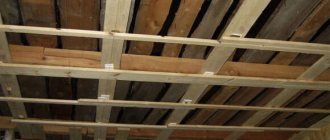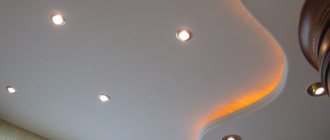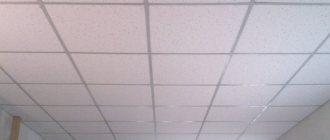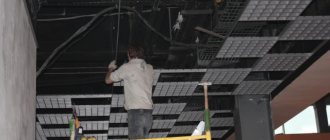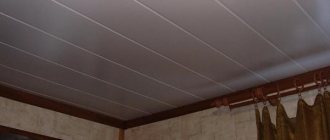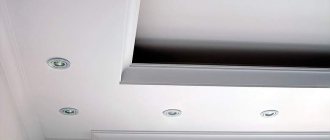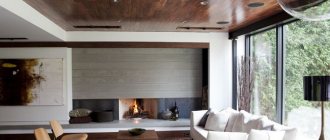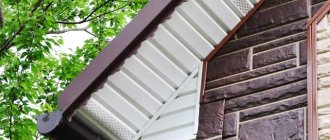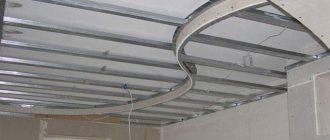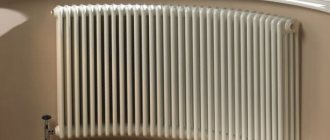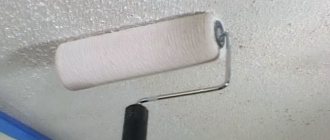Ceiling decoration with clapboard is increasingly used in the process of improvement of apartments. The lining ceiling is assembled according to the design principle without the use of glue or mortars, and after fastening the material does not need to be puttied or painted. This means that as a result of little effort, a completely finished surface is obtained. High-quality material, properly selected tools and clear instructions are all you need to create a beautiful and durable ceiling.
Selecting lining for the ceiling
More recently, when it came to ceiling lining, it was wooden figured strips that were meant. However, currently the construction market offers several types of lining. Based on the intended purpose of the room, material capabilities and buyer preferences, you can choose one or another material.
The material for making lining can be:
- wood;
- polyvinyl chloride;
- MDF boards.
It is worth going into more detail on each of the materials.
Product classification
When choosing a material for lining a ceiling with clapboards, you need to have a good understanding of the existing classification of such products. It is known that commercially available lining can be divided into four groups based on build quality. The described building material may correspond to one of the following quality categories:
- Class “A” products are intended for cladding ceiling structures. It may have various errors, including the presence of resin stains, blind cracks and knots.
- Class “B” products are considered higher quality building materials, but are not used in residential buildings due to non-compliance with aesthetic requirements.
- Class “C” products cannot boast of high quality, so they are used only when performing external work, for example, cladding sheds, utility buildings and other structures located on the street. In this case, the lining may have many falling knots, through cracks and pockets with resin.
- Lining of the “Extra” category is the highest quality solution, in which there are practically no visible or invisible defects. This material can be used to beautifully cover both the kitchen, the hallway, or any other part of the room.
Having information about this classification, you can successfully choose wooden lining for the ceiling, and also avoid irreparable mistakes at the stage of making a purchase. Once in the store, you need to communicate with a specialist as much as possible, ask questions and not be afraid to conduct an in-depth inspection of specific products.
Wooden lining
When finishing the ceiling with wooden paneling, the natural rustic style of the room is preserved. Wood lining is used in premises for any purpose and is absolutely safe for human health. The price of this building material varies depending on the type of wood. Most often, lining is made from alder, cedar, fir, oak, aspen, larch and other types of wood.
Pine has antiseptic properties because it is rich in resins. These substances cause mold to form on the surface of the lining. In addition, pine itself is considered a fairly smooth tree, with a small number of knots, which makes it ideal for creating lining.
Lining made from coniferous wood is considered almost universal, unlike hardwood, which is used mainly indoors. However, any wood is susceptible to moisture, so it must be impregnated with special products and provide air access to ventilate it.
Depending on the quality of the wood, there are 4 types of lining:
- Top class (extra). This board looks perfect in appearance, there are no chips, dents or cracks on it. The price of such material is very high, since it is made by splicing. At high humidity, this material begins to crack, so this lining is not used in damp rooms.
- Class A. Small knots are allowed, but there are no other defects on such material. As a rule, it is this category of lining that most consumers choose.
- Class B. There may be small defects on the surface of the board. Although such lining is usually not used in residential premises, it is best suited for cladding balconies and country houses.
- Class C. This is the lowest grade material, which has a large number of knots and defects.
Lathing for lining: step-by-step instructions
Preparation of the bar
The material for work should be prepared in advance. The timber should be kept for several days in the room where the finishing will be done. This will allow the building materials to acclimatize, and their temperature and humidity will become similar to that in the room.
Next, the sheathing elements are treated with an antiseptic compound (if possible and, if necessary, with an insecticide). This can be done either using ordinary brushes, processing everything in order and carefully. If the volume of work is large enough, then you can build a small trough from boards and cover it with polyethylene. We pour an antiseptic composition there and dip each of the bars. This option will provide high-quality protection against mold and mildew.
Antiseptic trough
Preparing the walls
While the timber is drying, we prepare the surface of the walls. To do this, mark the width of the racks using a pencil and using a level so that all the lines are as even as possible. Such a “drawing” will allow you to clearly see how the entire structure will subsequently look, simplifying the work and controlling the correct location of the sheathing elements.
You should also determine the starting point for installing the sheathing. It can be the lowest corner available in the room (we find it using a water or laser level). After the necessary measurements, we draw out the wall and draw a horizontal line.
Marking
Lathing with timber
How to hide wall defects
If the unevenness is significant, then it is necessary to secure the beam using special hangers, which should be positioned in a line (every half a meter) and secured perpendicularly. The prices for this type of fasteners are low, so the costs will not increase significantly. When fastening, the ends of the hangers are bent in the direction of the bar, after which it is leveled and fixed. This option is convenient due to its simplicity and accuracy: you can level surfaces quite quickly and easily.
Wooden wedges can also be used: they are the most important element for leveling significant unevenness in the surface of the walls. Prepare a certain number of wedges of different sizes in advance and treat them with antiseptics. As practice says, they tend to come in handy in most cases.
Hangers will help align the frames evenly
The installation of the sheathing under the lining is constantly monitored by level. We check the position of the bars and only then fasten them. To strengthen the angle, you can install a jumper in these places. This ensures maximum rigidity of the frame and simplifies fastening in corners.
Characteristics of MDF lining
In appearance, a ceiling made of MDF paneling resembles a wooden laminate, although this material is, in fact, a board made of pressed sawdust. This material is very sensitive to moisture. At the slightest contact with water, it begins to swell, losing its appearance and original quality.
It is worth noting that MDF paneling is used more often for walls than for ceilings. It allows you to organize various decorative elements and diversify the interior. In addition, the material has high thermal and noise insulation qualities.
If desired, you can combine MDF lining with different colors and textures. Installation of such material is not difficult.
What is a lining
Lining for ceiling cladding is represented by thin planks with a special type of connection, when the protrusion of another element is inserted into the groove of one plank.
The variety of types and quality of the material makes it suitable for installation in rooms with different operating conditions, and you can easily cover the ceiling with clapboard with your own hands. Panels are made from:
- solid wood species;
- MDF boards;
- plastic.
For example, for a bathroom or kitchen it is preferable to install plastic that is resistant to moisture, is not afraid of fungus, and is easy to wash. Wooden boards or MDF are best used in living rooms.
Features of polyvinyl chloride lining
Covering the ceiling with PVC lining is an excellent option, since the material is very easy to handle and easy to install. However, it is worth remembering that PVC planks are fragile and very easy to damage.
There are two types of PVC lining:
- with seams;
- seamless.
Seamless lining allows you to create an almost seamless, smooth surface on which the seams between the individual planks will be almost invisible. If you want to create a surface reminiscent of eurolining, you should use panels with seams.
One of the main advantages of polyvinyl chloride panels is that they are resistant to wet environments. However, you should avoid exposing such a ceiling to direct sunlight, since under ultraviolet radiation the lining will begin to lose its original color.
Thus, the best options for finishing the ceiling with clapboard would be plastic (PVC) panels, as well as wooden planks.
Choosing the right option
When trying to find the perfect lining ceiling in a modern style, you need to know about the main selection criteria, types of material and its design features. Due to the wide variety of models, it can sometimes be difficult to make a decision and choose what is really suitable for a particular home. To avoid mistakes, you should take into account all the nuances, even the most insignificant ones.
The low quality of the lining can be indicated by its packaging. If the material is wrapped in regular plastic film, it is better to discard it. The fact is that sellers will not allow you to tear the film for a visual inspection of the panel, and under such a coating the material will be vulnerable to moisture due to the lack of good ventilation. This packaging method negatively affects even the most elite types of wood.
At the selection stage, it is necessary to carefully evaluate the condition of the plate and make sure that there are no bends or defects on it. If this is not the case, it is better to refuse the product, since it is not of sufficient quality and various difficulties will arise during installation. And the consumer will not have any guarantees that such a ceiling structure will last too long.
If there are no noticeable visual distortions, it is necessary to additionally examine the surface and texture of the lining. It may contain transverse waves, especially at the junctions of structures. Such elements should not have chips or cracks, as this will impair the efficiency of installation work. It is very good if, when inspecting products, a special clip is used, which allows you to quickly determine the waves. If there are such distortions, a specific model of lining should be abandoned.
It is also necessary to check the surface of the material for moisture content. For this, a special device is used, which must be at the point of sale where the selection takes place. If you correctly assess the condition of the product and pay attention to all the details, this will be the best guarantee of the high quality of the final product.
Material calculation
Before covering the ceiling with clapboard in a wooden house, you should take care of purchasing a sufficient amount of material so that during the work you do not need to take breaks for additional purchases. The standard dimensions of one lining board are 15 cm wide, 600 cm long and 1.2-2.5 cm thick. These are the requirements of GOST 8242-88.
For interior decoration, panels with a thickness of less than 1.6 cm are used, and for exterior decoration, panels with a thickness of 1.8 cm or more are used. To determine the number of boards for finishing the ceiling with eurolining, you need to calculate the area of 1 plank and compare it with the total area of the surface to be sheathed. Thus, if we take a panel 9.5 cm wide and 6 m long, its total area will be 0.57 m2.
Let's assume that the total ceiling area in the room is 9 m2. Then for work you will need 9÷0.57=17.3≈18 boards. This is the minimum number of panels, since during the cladding process the width of the canvas will be reduced due to the peculiarities of the installation of the lining. It is fastened with a comb into the groove.
Plaster
Plastering the ceiling surface in wooden houses used to be in great demand.
Plaster is often used in modern cottages, however, it is gradually becoming a thing of the past, since there are enough other materials in the assortment. The plaster is applied to a mesh of shingles, which was stuffed between the beams. The solution firmly adheres to the relief mesh and shingles, which ensures the strength and durability of the coating. It is almost impossible to plaster the ceiling with your own hands without a certain skill. Plastering is a complex and time-consuming procedure that must be performed by professionals. Do you want to buy a sunflower? Visit https://agronizer.ua/ru/selkhozprodukciya/podsolnukh/! Current prices for sunflowers, placement of volumes for purchase and sale!
The advantages of this option are:
- affordable cost of both the material itself and plastering services. And if you do the finishing yourself, you won’t have to endure large expenses;
- high attractiveness, wide color palette and the ability to create a surface with a variety of relief;
- durability and practicality.
The disadvantage of such finishing of ceilings in a wooden cottage is the need for thermal insulation of the walls, carried out from inside the room. After all, thermal insulation boards act as an excellent basis for the subsequent fastening of reinforcing mesh. But such technology hides the usable area of the room, which is undesirable if it is not very large anyway.
Material quality control
After you have decided on the type, color, and quantity of the lining and delivered it to the work site, you need to check its quality. All panels should be laid out on a horizontal, flat surface and checked to see how well they correspond to the stated characteristics. Sometimes unscrupulous sellers place defective samples inside the packaging to avoid losses due to their rejection. Of course, it is advisable to pay attention to this during the shopping process in the store.
The next step if you plan to work with wood paneling is to dry it. PVC and MDF panels do not require this manipulation. To prevent the wooden lining mounted on the ceiling from becoming deformed, it must be thoroughly dried on a horizontal surface. The minimum drying period is 2 weeks, but a longer interval is allowed. If you do not want the wooden ceiling lining to soon lose its presentable appearance, drying cannot be neglected.
Work order
To reduce the number of trims during installation to a minimum, the length of the panels must be a multiple of the length (width) of the ceiling.
To file the ceiling you will need the following materials and tools:
- lining;
- screws or clamps;
- screwdriver (if you use self-tapping screws);
- hammer (if using clamps).
If the length of the ceiling in the direction of the lining is more than 6 m, then fastening should begin alternately with pieces of different lengths - in a checkerboard pattern. The first row is from a whole panel, the second from a piece, etc. This is necessary so that the joints are not noticeable.
The finishing material is attached to the frame using self-tapping screws or clamps. The tongue-and-groove connection allows you to quickly and accurately assemble the entire ceiling. For beauty, the perimeter of the sheathed ceiling can be sewn up with a special wooden corner.
The ceiling made of wooden paneling looks like one whole canvas. Most often decorates country houses, dachas and baths.
Preparation of tools and materials
To install the lining on the ceiling as quickly as possible, it is worth preparing in advance all the tools that may be needed during the work process:
- a hammer drill with a drill with a cross-section of 6-7 mm (if you have to work with a concrete ceiling), or an impact drill;
- screwdriver;
- electric jigsaw or hacksaw (tools are suitable for any type of lining);
- level;
- roulette.
In order to cover the ceiling with clapboard, you will need to purchase a number of auxiliary materials.
Since the lining is attached to the frame, that is, the sheathing, you need to choose the type of material for it:
- Wooden slats - they are best suited for fixing any type of lining, since working with them is easier and more convenient, and their cost is much lower than metal profiles.
- Metal lathing made of steel profiles. It is usually used for fastening plasterboard sheets.
It is worth noting that for working in rooms with high humidity, it is recommended to choose a steel version of the lathing and PVC lining, since they do not deform under the influence of moisture, unlike wood.
For a wooden frame you will need:
- strip 4x4 cm based on surface area;
- wooden or plastic wedges for the frame;
- brackets;
- self-tapping screws
For metal sheathing you need to purchase:
- steel profiles;
- fasteners;
- pendant;
- self-tapping screws;
- anchors.
You can begin installing the lining on the ceiling after purchasing materials and thoroughly drying the wood.
What you need to prepare for installation
This material is very easy to process and therefore, ceilings of this type can easily be assembled with your own hands, without the involvement of outside specialists. Everything that may be required for this is presented in the list below.
- Hammer
- Roulette
- Screwdriver
- Jigsaw or regular hacksaw
- Level
- Marker for marking
In addition, you can use a special tapping cord, with which it is very convenient to apply markings to the ceiling and walls. Instead of a regular building level, you can use a laser level, which will greatly speed up the process of assembling the structure.
Preliminary work with the ceiling
It is very important before making a lining ceiling to prepare it correctly. First, you need to remove a layer of old plaster from the ceiling surface and clean the surface from dirt so that it is as smooth as possible.
Next, we proceed to marking the ceiling for the frame. In this case, it is worth deciding on the direction of the lining strips. In the process of further laying the lining on the ceiling, it is advisable to place it so that there are as few end joints as possible.
Since wooden elements are susceptible not only to moisture, but also to mold, they must be coated with an antiseptic before installation.
In private houses, the ceiling should be pre-insulated. A layer of thermal insulation is laid between the profile posts, mounted with an indentation of 50-60 cm. If we are talking about an apartment, then additional thermal insulation is not needed.
Next, we find a level for attaching the sheathing. Having decided on the direction of the slats, we mark the ceiling. Please note that the lining is fixed perpendicular to the sheathing beams. If desired, it can be placed at right angles to the walls or diagonally.
Retaining brackets are fixed to the ceiling with equal intervals between them. Then wooden slats are laid on the brackets, leveling them using small wedges.
In order for eurolining ceilings to be beautiful, the lathing must be installed very carefully and perfectly level.
The maximum step between fasteners is 50 cm. If eurolining is used, then the step must be halved.
Its final appearance and durability depend on how carefully you pay attention to the preliminary preparation of the ceiling.
How to attach a wooden frame
The first step is to mark the future ceiling from the lining. To do this, you need to find the lowest point on your ceiling from which to measure down the wall 6-10 centimeters and put the first mark. It will need to be transferred to all walls using a water or laser level. It is according to these marks that you will check the horizontalness of the mounted frame for the future ceiling.
Important! When using wooden beams or other wood materials, remember that they must be pre-treated against the appearance of various pests, rot and to increase fire safety.
Wooden beams are mounted to the ceiling strictly perpendicular to how the lining itself will be mounted. The step between the bars should not exceed more than 100 centimeters. If the finishing material is PVC panels, then the pitch of the beams should not exceed 60 centimeters.
Please note: We paint the ceiling with water-based emulsion: from preparation to the last layer
If you decide to make the ceiling not only elegant, but also improved, for example: to lay sound insulation or thermal insulation on the ceiling, then in this case the step between the beams should in any case be no more than 60 centimeters. Since usually the so-called “slabs” of mineral wool or other heat and sound insulating material are also 60 centimeters wide. The bottom edge of all beams should be parallel to your floor and flush with the rest of the beams. Be sure to use a water level.
We fasten two beams along two walls on different sides. The distance from them to the wall should not exceed 15 centimeters. We clearly check the level not only in the middle, but also along the edges of the beams. Next, we continue to install the beams in increments of 60 centimeters, checking our work using a level at different points. In places where the beam lags behind the ceiling due to curvature, it is necessary to place wooden pads, which can be made from the remains of the beam itself. Next, we stretch the fishing line and use it to fasten the entire frame for the ceiling from the lining.
If you are not sure of the reliability of the structure you have made, then you can install additional cross bars, which will also ensure the rigidity of the entire structure. You can strengthen it only at those points where, according to your plan, lamps or other elements will be installed. Be sure to carry out all the necessary wiring before installing the beam. That’s the whole principle of making a wooden frame for lining ceilings.
Fastening the lining
Installing lining on the ceiling with your own hands is not something too difficult; even inexperienced performers can do it. True, it is advisable to work with the paneling together to make it easier to fasten long panels.
We begin to attach the lining to the ceiling with our own hands, perpendicular to the sheathing from the wall. The first board is tightly fixed to the wall with a tenon. Using a level, adjust the position of the board and then secure it. To lay the lining, you can use both small nails and clamps. In those rooms where the design of the lining ceiling should be ideal, clamps are used, and in other rooms, ordinary nails are also suitable.
Then we take the next board and insert it with a tenon into the groove of the previous one. At the points of contact between the panel and the sheathing, we firmly fix the board. We fix all other lining panels onto the battens in the same way.
On the opposite wall, the last strip of lining may need to be trimmed. In this regard, it is advisable to place it in a place where it will be least noticeable. When working with plastic panels, it is better to use a hand saw, while wooden lining and MDF panels are easier to cut with a jigsaw.
It is better to make any holes for wiring or mounting lighting fixtures immediately at the time of fixing the lining, so as not to damage it.
If you use nails to cover the ceiling with clapboard yourself, then you must first cut off their heads. At the end of the work, the nail holes are opened with wax.
The final stage of arranging a lining ceiling will be attaching the baseboards around the perimeter of the room. These decorative elements will add completeness to the ceiling and hide the gaps along the edges. Typically, wooden lining is opened with varnish, and baseboards with a darker stain and varnish. If desired, this ceiling can be painted.
What interior styles is it suitable for?
Traditionally, clapboard ceiling lining is considered a sign of village life and is associated primarily with country life. However, it complements well the space of some other interior trends: wooden slats on the ceiling can decorate a room decorated in the following styles:
- Modern. A variety of materials are suitable: tinted, laminated, glossy, matte. Light colors are preferred, but a certain exclusivity is also important. Various methods are suitable for its creation: inserts, figured layout, combination with point sources, LED strip.
Calm interior in a modern style Source cloudinary.com
- Provence. Paneling made of boards in pastel colors (milky, off-white, light blue) will fit perfectly into the image of an exquisite French style. A good addition would be beams of a contrasting color to the main ceiling.
Delicate colors of Provence Source hzcdn.com
- Scandinavian. The priority is light shades and a minimum of creativity in terms of inserts and combinations. Preference is given to a simple canvas made of tightly fitted boards, possibly with an aging effect. A good addition would be a figured plasterboard plinth.
Children's room design Source hzcdn.com
- Loft. The ceiling cladding is given a slightly careless, shabby, brutal look, for which brushing is well suited. Whether the color of the planks will be dark or light depends on the overall concept of the interior.
Wooden paneling in a loft bedroom Source behance.net
A few recommendations for ceiling cladding
Here are some useful tips that may be useful to you:
- Before covering the ceiling with eurolining, it is advisable to check how good the electrical wiring and other communications running under the ceiling are. If in the future you have to dismantle the lining for repairs, it can be damaged.
- The ceiling lining in places of contact with electrical wires must be insulated to prevent fire.
- When working with wooden panels, it is advisable to use fasteners that will not rust. For PVC panels, the type of fastening is not important.
- Ceiling covering should be done in a dry room at a temperature not lower than 10 ℃.
Useful tips
Having completed the installation of the ceiling, all that remains is to provide it with proper care. This is necessary to extend the service life of the structure and preserve external beauty for the maximum period of time. So, in order for the lining to be pristine, it is enough to take into account the following recommendations:
- It is better to avoid getting moisture on the material.
- When cleaning, it is recommended to use a vacuum cleaner or a dry cloth.
- A weak solvent is used to remove stains.
- From time to time it is necessary to treat surfaces with antipyrines and antiseptics.
- The lining must be secured carefully and carefully.
Modern ceilings made of eurolining are found both in brick or wooden houses, and in private apartments. When using this type of ceiling upholstery, it is advisable to give preference to proven materials that demonstrate the best performance characteristics. A good solution is lining with patterns. It will be relevant for a loggia or attic, as well as country houses.
The cost of a lining ceiling
The final cost of ceiling repair will largely depend on the price of materials. In turn, the price of lining varies depending on the type and species of wood, the length of the board, as well as production technology.
Depending on these factors, lining is divided into several categories by price:
- The most expensive is considered to be lining made of soft hardwood. Their processing is carried out in accordance with European standards.
- Hardwood lining falls into the middle price category.
- Lining made from softwood is the cheapest.
In addition, if you want to equip a two-level ceiling made of clapboard, you may have to invite a specialist, whose services you also need to pay for.
Important points
Ceilings covered with this method are not able to cope with possible differences in height and distortions. The sheathing used should be secured with dowels, and the fixation distance between the beams will depend on the material used. Having completed the installation of the frame, you can proceed to finishing activities. To simplify the work ahead, it is recommended that you start it together.
First of all, you should install the first panel using an awl. The boards are fixed perpendicular to the sheathing. Before fixing them, you need to adjust the position of the sheathing.
The second track is installed tightly into the grooves of the first. The remaining parts of the ceiling are fixed in exactly the same way as the previous ones. But often you have to work a little with the last board, trimming the remaining sections. To minimize the visibility of the seam, it is better to position it as far away from public view as possible. When performing installation work, you need to immediately determine the number and location of holes for lamps and wires.
Ultimately, you need to make upholstery with plinth around the perimeter of the ceiling. To give aesthetic appeal, it is better to treat the plinth and lining with varnish. The option of painting such structures is also being considered.
How to care for the ceiling
If we are talking about lining made of wood, it must be treated with antiseptic impregnations and primers that slow down the destruction of wood and prevent the development of fungus and rotting. When choosing a specific product, pay attention to its color, which should match the desired result.
Alternatively, wooden panels can be coated with a special oil, varnish or paint of your choice.
The processing option depends only on the wishes of the owner. In order for the ceiling to retain its presentable appearance longer, it is advisable to periodically wipe off dust from it. If just a damp cloth is not enough for cleaning, you can use special household products that are sold in large quantities in supermarkets.
Nuances of frame installation
The wooden frame is optimally made from timber 40 by 40, 20 by 40, or 50 by 50 mm. Fastening the beams, as well as their fixation to the ceiling, walls, is carried out with plastic dowels and nails - screws (size 8 by 45 mm), or anchors and hardened screws (4 by 75 mm, for wood). When choosing a metal frame you will additionally need:
- UD profile for perimeter formation;
- U-shaped fastening options, as well as cross “crab” fasteners;
- screws for metal, “fleas” with tips in the form of a drill;
- CD profile for frame
The amount of material required for the work is calculated after a detailed study of the instructions. To nail the lining to the ceiling, you will need a construction stapler, nails, self-tapping screws with press washers.
When creating a wooden frame, pay attention to the following points:
- When adjusting the slats, leave a 4-5 mm gap on both sides along the entire length to prevent deformation of the material during expansion.
- Do not try to immediately cut wooden slats across the entire ceiling surface. The length adjustment is individual, and therefore each new workpiece must be cut immediately before fastening. This will save materials, but you will have to spend more time on fitting.
- There is no need to fix the workpiece with nails; just insert it into the lock of the previous plank.
If there are any difficulties with insertion into the lock (grooves), you will need a rubber hammer. With its help, you can tamp down the attachment point and adjust the rail. Next, the workpieces are fastened with self-tapping screws on all frame guides; it is better to fasten them in the area of the lock edge.
